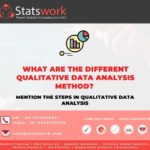What is qualitative data analysis method? Mention several methods available to analyze qualitative data
In-Brief
- Qualitative data analysis service helps to determine the particular frequency of traits or characteristics.
- Qualitative data analysis in business research allows researchers and statistician to have parameters through which data sets observed.
- Qualitative research is more preferred because it is more scientific, objective, fast, focused and acceptable
Introduction
Data analysis for qualitative research is the task of reviewing, organizing, transforming and modelling of collected data to identify their relationship, similarities and connections. Qualitative data analysis rely entirely on narrative or descriptive information such as interview, conversation, video, audio recordings, images and text documents. Most of the data fall on this type, so it is known as categorical data.
Analyzing Qualitative Data
The type of Statistical data analysis in qualitative market research works differently from other data analysis methods because primarily qualitative data is data made up of words, observation, images and even symbols. Deriving absolute meaning from these types of data is challenging. So, it mostly used in exploratory research. Quantitative analysis has a clear distinction between data preparation and data analysis, analyze of the qualitative research begins when the data is available.
Data preparation and basic data analysis
The analysis and preparation stage of the basic data is a parallel process:
- Getting familiar with the data:
Qualitative research is a field of study that relies on exploring, describing, and interpreting the innate quality of entities. Most of the qualitative data analysis is descriptive or narrative, so, it is mandatory to get familiar with the data before handling the data. Market research qualitative data analysis experts first get familiar with the data by start looking for basic observation or patterns. They may also look for past data collection to gain some knowledge to analyze the data.
It also includes transcribing the data. Data transcription is an important process and a necessary component of qualitative research. It is the process by which audio or video recording sometimes both that translated into words that can then studied and coded. Data accuracy and authenticity is the important detail in performing data transcription.
- Revisiting research objectives:
This step starts after the transcribing process. The researchers revisit the area that needs research and identify the problem statement or central question in the research that is left unanswered chosen. Identifies a various list of question that brings clarification to the research are listed. Cross-checking those questions with the collected data and brings clarity to the research question. This process is the main process because it is the process that brings clarity to the research and finds a solution to overcome the gap in research.
- Developing a framework:
The framework is developed by summarising the mental image of the themes and patterns that were emerging the data. Researchers usually collect relevant information before starting the framework development process. PhD Dissertation Qualitative Data Analysis Help builds a framework using the variables from different scientific articles that address a knowledge gap in other research.
- Identifying patterns and connections:
After the completion of data, code can start identifying the themes and look for the most common responses to questions. Online company and management data collection tools rely entirely on identifying the data patterns that can answer the research question and finding further areas that yet left unexplored.
Qualitative data analysis methods
There are several methods available to analyze qualitative data, they are:
- Content analysis:
Content analysis is the common analysis method to analyze qualitative information. It determines the presence of certain words, themes, concepts with the given qualitative data. There are two types of content analysis they are conceptual analysis and relational analysis. Conceptual analysis is the process to determines the existence of concepts in a text. The relational analysis is the second step done after conceptual analysis that develops by examining the relationships among concepts in research. The different types of analysis lead to different results and meaning. Qualitative data analysis in market research data uses content analysis to analyze responses from the interview.
Benefits of Content analysis:
- It identifies the intentions, communication trends of a person, group or organization
- Relatively describe attitudinal and behavioural responses to communications
- It determines the psychological or emotional state of person or group of people
- Narrative analysis:
The narrative data analysis is a technique used to study authors perspective through developed research. Researchers develop the technique based on the idea that the author reveals. By evaluating the writing, you come to know about the ideas and intension of the author. One can also use the narrative data analysis to evaluate the relevance and significance of the study to determine whether you can use the information in your research or not. It includes authors bias and also evaluates the misleading significance that the researcher placed in their research. Usually, the narrative data analysis should always focus on your primary research question or thesis statement. It should include questions related to a specific event, time, group of people, individual or circumstance based on the research.
- Grounded theory:
The grounded theory uses qualitative data to explain why certain phenomena happened. Online survey data collection tools in research study utilize a variety of similar cases in different settings and use the data to derive an explanation for the research. By conducting this, researchers may alter the explanation or create a new one as the study fit all the case explanation.
Conclusion
Data analysis is perhaps the essential component of research. Weak analysis procedure lead to inaccurate results that resemble the authenticity of the research. Qualitative business research and analysis guides you in choosing your data analysis method carefully to ensure that your findings are manageable and actionable.
References
- Thomas, D. R. (2006). A general approach for analyzing qualitative evaluation data. American journal of evaluation, 27(2), 237-246.
- Morgan, D. L. (1993). Qualitative content analysis: a guide to paths not taken. Qualitative health research, 3(1), 112-121.
- Assarroudi, A., Heshmati Nabavi, F., Armat, M. R., Ebadi, A., & Vaismoradi, M. (2018). Directed qualitative content analysis: the description and elaboration of its underpinning methods and data analysis process. Journal of Research in Nursing, 23(1), 42-55.
- Sgier, L. (2012). Qualitative data analysis. An Initiat. Gebert Ruf Stift, 19, 19-21.

 Previous Post
Previous Post Next Post
Next Post